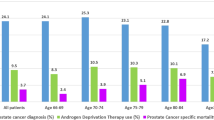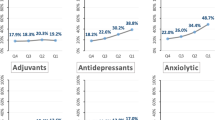Background
The increasing use of androgen deprivation therapy has prompted further evaluation of its potential adverse effects as the treatment may exacerbate or increase the risk of developing new comorbid diseases. This study aims to assess the patterns of comorbidities among Australian men with prostate cancer treated with androgen deprivation therapy.
Methods
Pharmaceutical Benefits Scheme (PBS) 10% data between 1 January 2003 and 31 December 2014 was utilised in this retrospective cohort study. Men who had received their first androgen deprivation therapy between 2004 and 2010 were selected as the prostate cancer cohort. Comorbidities were identified using the dispensing claims data and classified with the Rx-Risk-V model. Comparisons were made between the prostate cancer cohort and specific control groups (age-matched and sex-matched without any dispensing of anti-neoplastic agents during the study period and without the individual comorbidity of interest evaluated at baseline at 1:10 ratio) for the development of nine individual comorbidities over time using Cox regression models.
Results
The prostate cancer cohort had a significant higher risk of developing cardiovascular conditions (hazard ratio 1.37, 95% CI: 1.26–1.48), depression (1.86, 95% CI: 1.73–2.01), diabetes (1.30, 95% CI: 1.15–1.47), gastric acid disorders (1.48, 95% CI: 1.39–1.57), hyperlipidaemia (1.18, 95% CI: 1.09–1.29), osteoporosis (1.65, 95% CI: 1.48–1.85) and pain/pain-inflammation (1.47, 95% CI: 1.39–1.55) compared to the control groups. The hazard ratios for cardiovascular conditions and depression were highest in the first year and declined over time. There were no significant differences between the two groups for reactive airway diseases and Alzheimer’s disease.
Conclusion
Men with prostate cancer treated with androgen deprivation therapy had a higher likelihood of developing new comorbidities than men who did not receive androgen deprivation therapy. Our results support the need for developing coordinated care models that effectively address multiple chronic diseases experienced by prostate cancer survivors.
This is a preview of subscription content, access via your institution
Access options
Subscribe to this journal
Receive 4 print issues and online access
$259.00 per year
only $64.75 per issue
Buy this article
- Purchase on Springer Link
- Instant access to full article PDF
Prices may be subject to local taxes which are calculated during checkout



Similar content being viewed by others
References
Australian Government Cancer Australia. Prostate cancer statistics. Australian Government Cancer Australia. 2017. https://prostate-cancer.canceraustralia.gov.au/statistics. Accessed 21 Sept 2017.
Baade PD, Fritschi L, Eakin EG. Non-cancer mortality among people diagnosed with cancer (Australia). Cancer Causes Control. 2006;17:287–97.
Skolarus TA, Wolf AMD, Erb NL, Brooks DD, Rivers BM, Underwood W, et al. American Cancer Society prostate cancer survivorship care guidelines. CA Cancer J Clin. 2014;64:225–49.
Australian Institute of Health and Welfare. Australia’s health 2014. Australia’s health series no. 14. Cat. no. AUS 178. Canberra: AIHW; 2014. http://www.aihw.gov.au/publication-detail/?id=60129547205. Accessed 10 Oct 2017.
Macmillan Cancer Support, National Cancer Intelligence Network (NCIN), Monitor Deloitte. Routes from diagnosis: the most detailed map of cancer survivorship yet. United Kingdom: Macmillan Cancer Support; 2014. http://www.macmillan.org.uk/about-us/what-we-do/evidence/cancer-intelligence/routes-from-diagnosis.html. Accessed 14 Sept 2017.
Parker C, Gillessen S, Heidenreich A, Horwich A, on behalf of the ESMO Guidelines Committee. Cancer of the prostate: ESMO Clinical Practice Guidelines for diagnosis, treatment and follow-up. Ann Oncol. 2015;26:v69–v77.
Ong WL, Foroudi F, Evans S, Millar J. Large institutional variations in use of androgen deprivation therapy with definitive radiotherapy in a population-based cohort of men with intermediate- and high-risk prostate cancer. BJU Int. 2017;120:35–42.
Grossmann M, Hamilton EJ, Gilfillan C, Bolton D, Joon DL, Zajac JD. Bone and metabolic health in patients with non-metastatic prostate cancer who are receiving androgen deprivation therapy. Med J Aust. 2011;194:301–6.
Saigal CS, Gore JL, Krupski TL, Hanley J, Schonlau M, Litwin MS. Androgen deprivation therapy increases cardiovascular morbidity in men with prostate cancer. Cancer. 2007;110:1493–1500.
Keating NL, O’Malley AJ, Freedland SJ, Smith MR. Diabetes and cardiovascular disease during androgen deprivation therapy: observational study of veterans with prostate cancer. J Natl Cancer Inst. 2010;102:39–46.
Jespersen CG, Norgaard M, Borre M. Androgen-deprivation therapy in treatment of prostate cancer and risk of myocardial infarction and stroke: a nationwide Danish population-based cohort study. Eur Urol. 2014;65:704–9.
Lage MJ, Barber BL, Markus RA. Association between androgen-deprivation therapy and incidence of diabetes among males with prostate cancer. Urology. 2007;70:1104–8.
Wadhwa VK, Weston R, Mistry R, Parr NJ. Long-term changes in bone mineral density and predicted fracture risk in patients receiving androgen-deprivation therapy for prostate cancer, with stratification of treatment based on presenting values. BJU Int. 2009;104:800–5.
Shahinian VB, Kuo Y-F, Freeman JL, Goodwin JS. Risk of fracture after androgen deprivation for prostate cancer. N Engl J Med. 2005;352:154–64.
Australian Government Department of Health. Australian statistics on medicines 2011. Department of Health. 2013. http://www.pbs.gov.au/info/statistics/asm/asm-2011. Accessed 10 Nov 2017.
Mellish L, Karanges EA, Litchfield MJ, Schaffer AL, Blanch B, Daniels BJ, et al. The Australian Pharmaceutical Benefits Scheme data collection: a practical guide for researchers. BMC Res Notes. 2015;8:634.
Sloan KL, Sales AE, Liu CF, Fishman P, Nichol P, Suzuki NT, et al. Construction and characteristics of the RxRisk-V: a VA-adapted pharmacy-based case-mix instrument. Med Care. 2003;41:761–74.
Vitry A, Wong SA, Roughead EE, Ramsay E, Barratt J. Validity of medication-based co-morbidity indices in the Australian elderly population. Aust N Z J Public Health. 2009;33:126–30.
Lu CY, Barratt J, Vitry A, Roughead E. Charlson and Rx-Risk comorbidity indices were predictive of mortality in the Australian health care setting. J Clin Epidemiol. 2011;64:223–8.
Australian Institute of Health and Welfare. Australian burden of disease study: impact and causes of illness and death in Australia 2011. Australian burden of disease study series no. 3. BOD 4. Canberra: AIHW; 2016. https://www.aihw.gov.au/reports/burden-of-disease/australian-burden-of-disease-study-impact-and-causes-of-illness-and-death-in-australia-2011/contents/highlights. Accessed 14 Sept 2017.
Khan NF, Ward AM, Watson E, Rose PW. Consulting and prescribing behaviour for anxiety and depression in long-term survivors of cancer in the UK. Eur J Cancer. 2010;46:3339–44.
Pearson SA, Abrahamowicz M, Srasuebkul P, Buckley NA. Antidepressant therapy in cancer patients: initiation and factors associated with treatment. Pharmacoepidemiol Drug Saf. 2015;24:600–9.
Chen PM, Chen SC, Liu CJ, Hung MH, Tsai CF, Hu YW, et al. The association between prostate cancer and mood disorders: a nationwide population-based study in Taiwan. Int Psychogeriatr. 2015;27:481–90.
Kumar RJ, Barqawi A, Crawford ED. Adverse events associated with hormonal therapy for prostate cancer. Rev Urol. 2005;7:S37–S43.
Taylor LG, Canfield SE, Du XL. Review of major adverse effects of androgen-deprivation therapy in men with prostate cancer. Cancer. 2009;115:2388–99.
Chung S-D, Kao L-T, Lin H-C, Xirasagar S, Huang C-C, Lee H-C. Patients receiving androgen deprivation therapy for prostate cancer have an increased risk of depressive disorder. PLoS ONE. 2017;12:e0173266.
Dinh KT, Reznor G, Muralidhar V, Mahal BA, Nezolosky MD, Choueiri TK, et al. Association of androgen deprivation therapy with depression in localized prostate cancer. J Clin Oncol. 2016;34:1905–12.
Smith MR, Finkelstein JS, McGovern FJ, Zietman AL, Fallon MA, Schoenfeld DA, et al. Changes in body composition during androgen deprivation therapy for prostate cancer. J Clin Endocrinol Metab. 2002;87:599–603.
Mitsuzuka K, Kyan A, Sato T, Orikasa K, Miyazato M, Aoki H, et al. Influence of 1 year of androgen deprivation therapy on lipid and glucose metabolism and fat accumulation in Japanese patients with prostate cancer. Prostate Cancer Prostatic Dis. 2016;19:57–62.
Saylor PJ, Smith MR. Metabolic complications of androgen deprivation therapy for prostate cancer. J Urol. 2009;181:1998–2008.
Saad F, Adachi JD, Brown JP, Canning LA, Gelmon KA, Josse RG, et al. Cancer treatment-induced bone loss in breast and prostate cancer. J Clin Oncol. 2008;26:5465–76.
Wang H, Sun X, Zhao L, Chen X, Zhao J. Androgen deprivation therapy is associated with diabetes: evidence from meta‐analysis. J Diabetes Investig. 2016;7:629–36.
Morote J, Morin JP, Orsola A, Abascal JM, Salvador C, Trilla E, et al. Prevalence of osteoporosis during long-term androgen deprivation therapy in patients with prostate cancer. Urology. 2007;69:500–4.
Lester JF, Mason MD. Cardiovascular effects of hormone therapy for prostate cancer. Drug Healthc Patient Saf. 2015;7:129–38.
Nguyen PL, Je Y, Schutz FB, Hoffman KE, Hu JC, Parekh A, et al. Association of androgen deprivation therapy with cardiovascular death in patients with prostate cancer: a meta-analysis of randomized trials. JAMA. 2011;306:2359–66.
Holmes-Walker DJ, Woo H, Gurney H, Do VT, Chipps DR. Maintaining bone health in patients with prostate cancer. Med J Aust. 2006;184:176–9.
Bhatia N, Santos M, Jones LW, Beckman JA, Penson DF, Morgans A, et al. Cardiovascular effects of androgen deprivation therapy for the treatment of prostate cancer: ABCDE steps to reduce cardiovascular disease in patients with prostate cancer. Circulation. 2016;133:537–41.
Resnick MJ, Lacchetti C, Bergman J, Hauke RJ, Hoffman KE, Kungel TM, et al. Prostate cancer survivorship care guideline: American Society of Clinical Oncology Clinical Practice Guideline endorsement. J Clin Oncol. 2015;33:1078–85.
Parikesit D, Mochtar CA, Umbas R, Hamid ARAH. The impact of obesity towards prostate diseases. Prostate Int. 2016;4:1–6.
Paez Borda A, Charnay-Sonnek F, Fonteyne V, Papaioannou E. Guidelines on pain management & palliative care. European Association of Urology. 2013. https://uroweb.org/wp-content/uploads/25-Pain-Management_LR.pdf. Accessed 25 July 2017.
Chung SD, Lin HC, Tsai MC, Kao LT, Huang CY, Chen KC. Androgen deprivation therapy did not increase the risk of Alzheimer’s and Parkinson’s disease in patients with prostate cancer. Andrology. 2016;4:481–5.
Nead KT, Sinha S, Nguyen PL. Androgen deprivation therapy for prostate cancer and dementia risk: a systematic review and meta-analysis. Prostate Cancer Prostatic Dis. 2017;20:259–64.
Jhan JH, Yang YH, Chang YH, Guu SJ, Tsai CC. Hormone therapy for prostate cancer increases the risk of Alzheimer’s disease: a nationwide 4-year longitudinal cohort study. Aging Male. 2017;20:33–38.
Acknowledgements
Huah Shin Ng is supported by an Australian Government Research Training Programme Scholarship.
Author information
Authors and Affiliations
Corresponding author
Ethics declarations
Conflict of interest
The authors declare that they have no conflict of interest.
Electronic supplementary material
Rights and permissions
About this article
Cite this article
Ng, H.S., Koczwara, B., Roder, D. et al. Development of comorbidities in men with prostate cancer treated with androgen deprivation therapy: an Australian population-based cohort study. Prostate Cancer Prostatic Dis 21, 403–410 (2018). https://doi.org/10.1038/s41391-018-0036-y
Received:
Revised:
Accepted:
Published:
Issue Date:
DOI: https://doi.org/10.1038/s41391-018-0036-y
This article is cited by
-
Androgen deprivation therapy for prostate cancer and neurocognitive disorders: a systematic review and meta-analysis
Prostate Cancer and Prostatic Diseases (2024)
-
Access to nutrition services and information after active cancer treatment: a mixed methods study
Journal of Cancer Survivorship (2024)
-
Quantifying observational evidence for risk of dementia following androgen deprivation therapy for prostate cancer: an updated systematic review and meta-analysis
Prostate Cancer and Prostatic Diseases (2021)
-
Incidence of the adverse effects of androgen deprivation therapy for prostate cancer: a systematic literature review
Supportive Care in Cancer (2020)
-
Updates in advanced prostate cancer 2018
Prostate Cancer and Prostatic Diseases (2018)



